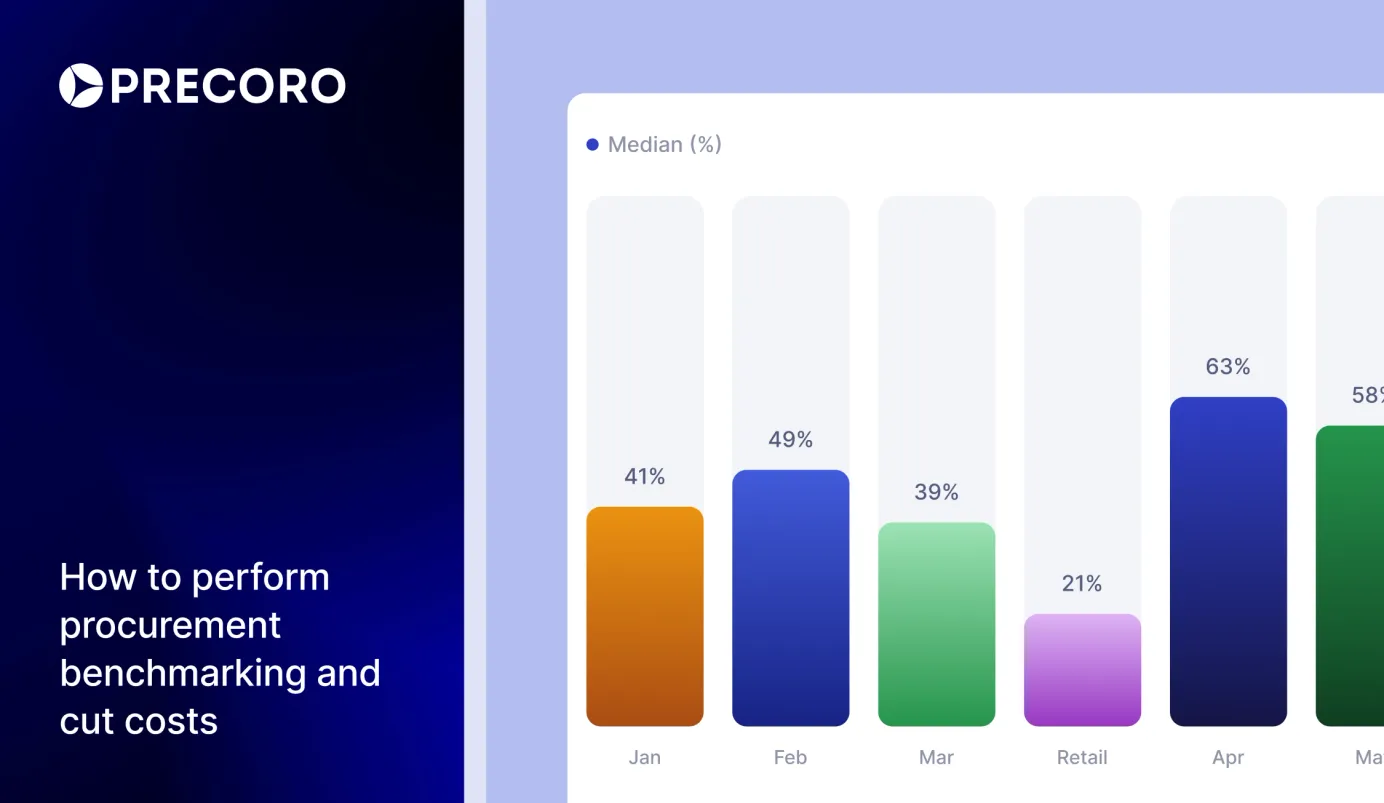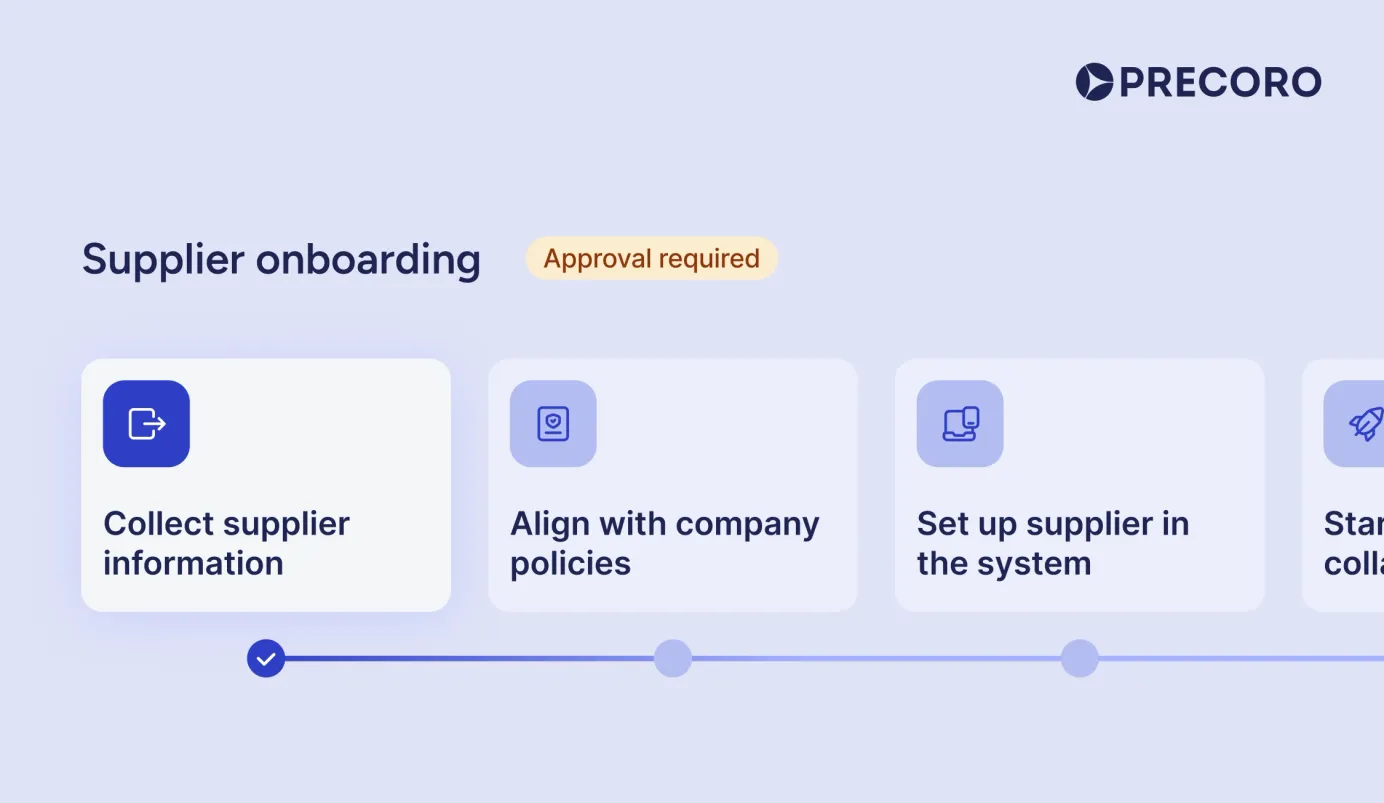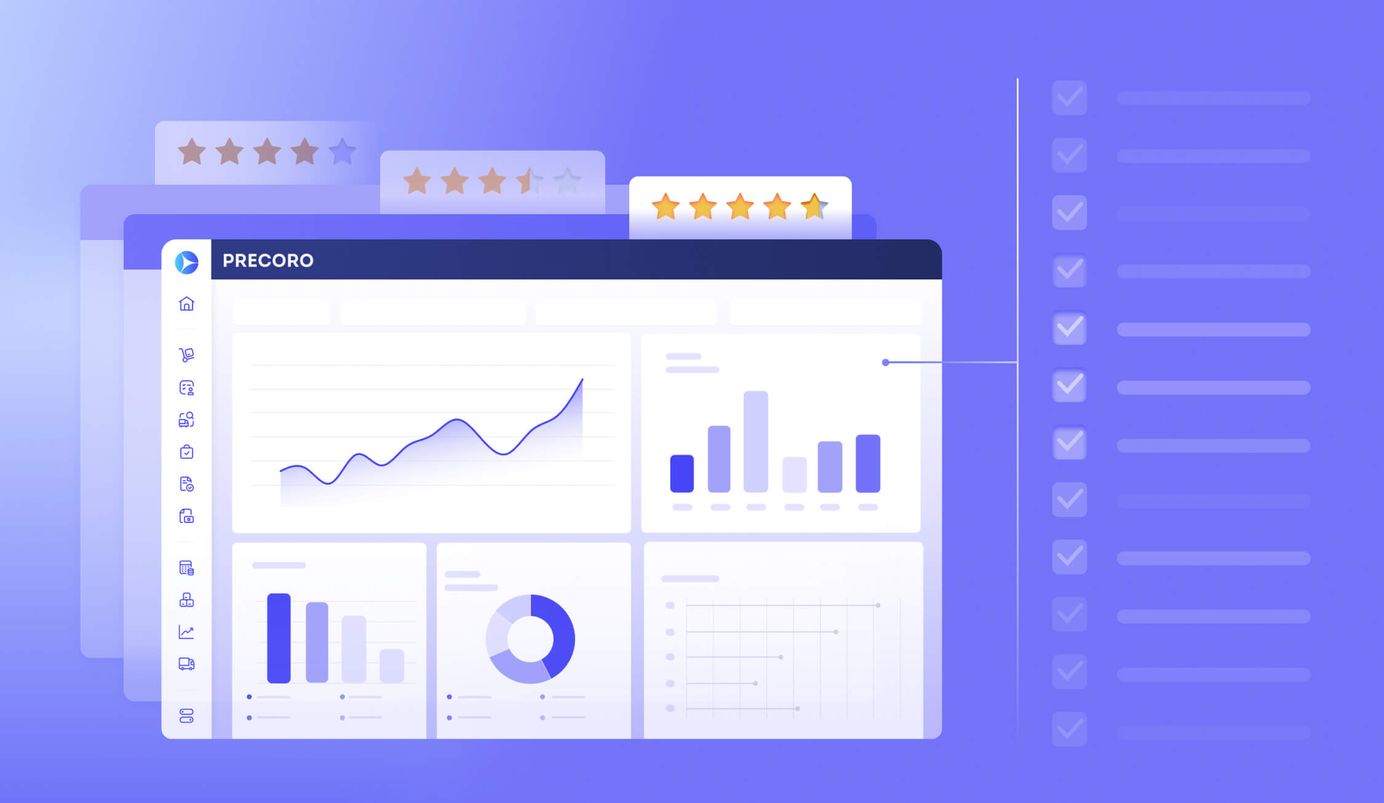
21 min read
Online Procurement System: Guide to Choosing the Right Tool
An online procurement system is essential for full visibility and control over budgets, expenses, and purchases. Learn how to choose the best fit for you.
In today’s digitalized world, more and more companies are moving away from paper and spreadsheet-based processes in favor of more accurate, simple, and efficient automation. According to the 2020 Forrester Consulting Thought Leadership Paper, 72% of business decision-makers agree that digital processing increases resilience.
Procurement operations are no exception. In fact, 43% of GPOs that took part in the 2023 Global Chief Procurement Officer Survey cited overall procurement risk had increased significantly as compared to 20% in the 2021 study. Businesses adopt online procurement systems to mitigate risks and to streamline requisitions, approvals, order placement, and spend management.
An electronic procurement (e-procurement) system is a digital solution that simplifies how businesses purchase goods and services. It replaces manual, paper-based processes with automated workflows and makes procurement faster, more efficient, and easier to monitor. E-procurement uses the internet or intranet to manage the full purchasing cycle, from requisition to payment.
However, with numerous e-procurement software vendors available, choosing the right tool can be overwhelming. This guide will walk you through the essential factors to consider when selecting the best e-procurement software for your organization.
Keep reading to learn:
- What is a procurement system?
- Challenges of manual procurement
- Key features of e-procurement software solutions
- Top e-procurement software
- Benefits of using an online procurement system
- Choosing the right online procurement system
- Frequently Asked Questions
What is an online procurement system?
Electronic procurement—often called e-procurement—is the process of requisitioning, ordering, and purchasing goods and services through an online system. It’s a business-to-business (B2B) process.
An electronic procurement (e-procurement) system is a digital platform that automates and simplifies the entire purchasing process, including sourcing, ordering, payments, and contract management. By replacing manual, paper-based methods with digital tools such as Electronic Data Interchange (EDI), ERP systems, and cloud-based platforms, e-procurement helps organizations increase efficiency, cut costs, strengthen compliance, and gain clearer visibility into spending.
At its core, an online procurement system centralizes purchasing activities. It offers a single interface where users can submit purchase requests, get approvals, select suppliers, place orders, process invoices, create receipts, and track payments. Online procurement management systems help companies avoid risks and inefficiencies associated with paper- or spreadsheet-based processes.
Additionally, automated systems and built-in monitoring tools help reduce procurement teams' workloads, improve performance, boost process efficiency, and drive cost savings. They also help prevent maverick spending, when employees make purchases outside of approved contracts and policies.
With e-procurement, companies gain access to a broader range of products and services tailored to their needs. Quickly finding items from preferred suppliers makes it easier to manage inventory levels and control costs.
By automating manual, repetitive, or low-value tasks, procurement teams can focus more on strategic activities like negotiating better contracts and building supplier relationships.
Challenges of manual procurement
While familiar, the manual approach to procurement introduces significant inefficiencies and risks that can hinder a company’s ability to manage its procurement activities effectively. These challenges are relevant for organizations across different industries, whether it's a construction business, renewable energy sector, hospitality, healthcare or other industries.
Let’s break them down.
1. Error-prone data entry
Manual data entry is inherently susceptible to human error. While tools like Google Spreadsheets and Excel offer features to help users identify typographical mistakes and ensure accurate calculations, data misalignment remains a common issue. It’s easy to enter incorrect item data or select the wrong budget line, particularly in companies with numerous budget categories.
These errors lead to inaccuracies in procurement records, resulting in incorrect orders, duplicated purchases, and increased costs. Moreover, procurement or accounts payable teams must spend considerable time identifying and correcting these mistakes, further reducing efficiency.
2. Lack of visibility and control
Spreadsheet-based records are often fragmented across departments, making it difficult to obtain a comprehensive view of spending, supplier performance, and order statuses. This scattered approach presents challenges for various stakeholders:
- Requesters can’t easily check if an item is already in stock at a warehouse, leading to unnecessary purchases. Additionally, they lack visibility into order statuses and must frequently communicate with approvers for updates.
- Approvers don’t have immediate access to budget information, making it difficult to determine if a purchase is within the allocated budget. They also need to verify item availability separately.
- Receivers must locate purchase orders (POs) to verify if items have been delivered in full.
- Payers often struggle to identify the relevant requester when receiving invoices, which makes it challenging to verify and process payments accurately.
- Inventory managers face difficulties maintaining accurate inventory levels due to disconnected systems, leading to overstocking or stockouts.
- Procurement managers find it challenging to track supplier performance and compliance, which can result in missed opportunities for better pricing and terms.
- Finance teams encounter delays in financial reporting and budgeting due to the time-consuming process of consolidating data from multiple sources.
Unlike with top e-procurement software, users who follow manual processes lack visibility and have to switch between various spreadsheets and tools to find necessary data. At best, this fragmentation leads to delays; at worst, it can hinder strategic planning and result in overspending.
3. Poor compliance and governance
Maintaining compliance with procurement policies and external regulations is challenging when processes are manual. Without a centralized e-procurement tool where they can follow established workflows and locate pre-approved items, employees may turn to unvetted suppliers or overpriced goods.
Additionally, manual procurement processes often lead to issues such as:
- Employees may rely on verbal approvals with approximate pricing, resulting in overspending when the final cost includes higher-than-expected prices, taxes, or shipping fees.
- Manual processes can result in incomplete or missing documentation, making it difficult to enforce procurement policies and comply with external regulations.
- The absence of a digital audit trail makes it challenging to track who approved what, when, and why, increasing the risk of non-compliance and fraud.
- Without an online procurement management system, tracking supplier performance and compliance with contractual terms becomes cumbersome, increasing the risk of working with non-compliant or underperforming vendors.
4. Limited scalability
Spreadsheets might work for a company that’s just starting out, but as a business grows and increases its volume of purchases and number of suppliers, things tend to get out of control. For starters, the manual entry and processing workload of procurement documents becomes unmanageable, leading to delays in order placement and fulfillment.
The larger the organization, the more stakeholders are involved in the procurement process, and the more approvers have to give the green light to purchase requisitions or purchase orders. Manual systems can create communication bottlenecks, slowing down approvals.
Additionally, managing a growing number of suppliers manually can result in poor relationship management. Without specialized software, e-procurement tasks such as tracking supplier performance, spending by supplier, and contract terms become difficult, often leading to missed opportunities for cost savings.
5. Increased risk of fraud
Manual processes lack the controls and audit trails provided by e-procurement management software. One of the major risks associated with a lack of transparency is fraudulent invoices. Looking through them is time-consuming and prone to oversight by the accounts payable team if they manually reconcile each invoice with the related PO and receipt. Thus, manual reconciliation increases the likelihood of fraudulent invoices slipping through and being paid.
One more risk is that manual processes make it easier to bypass proper vetting and approval steps for new suppliers, which increases supply chain vulnerabilities. Additionally, manual systems make it difficult to enforce segregation of duties, where different individuals handle requisition, approval, and payment. This lack of segregation, combined with the difficulty in tracking the creation and approval times of procurement documents, heightens the risk of unauthorized purchases and overspending.
When the challenges of manual procurement processes become too noticeable and overwhelming, companies seek efficient ways to centralize their procurement activities. They move beyond customizable spreadsheets and turn to e-procurement software solutions. Let’s explore how they work.
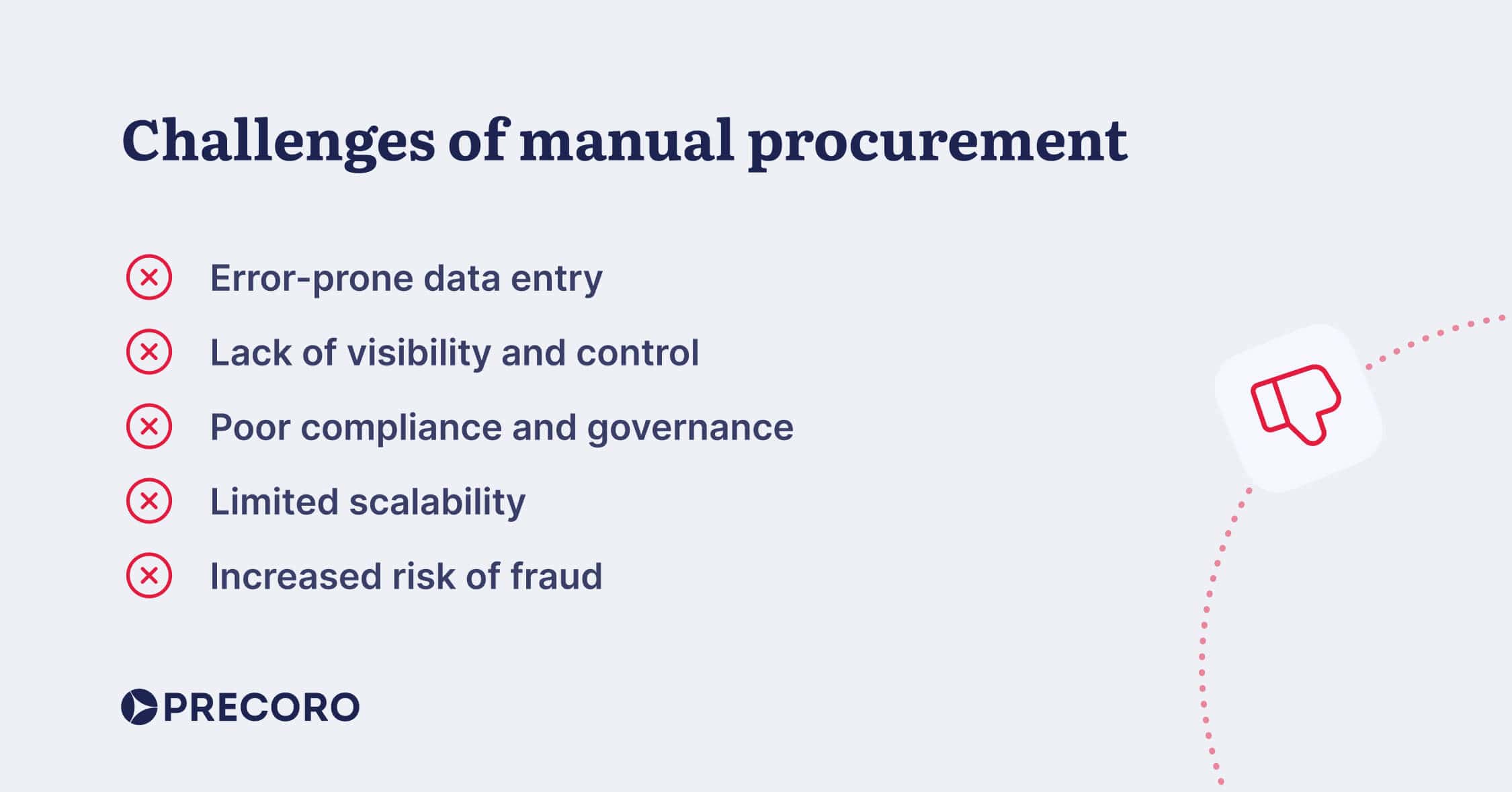
Key features of e-procurement software solutions
While the functionality differs from one e-procurement system to another, there are some core features to watch out for. When it comes to selecting purchasing software, e-procurement tools with the following modules will help employees overcome most if not all procurement challenges. They include:
- Budget control with the ability to set up and manage budgets for different locations, departments, and projects, ensuring that all expenditures stay within allocated limits.
- Requisition management with the ability for users to generate purchase requisitions, assign requisition numbers, track their statuses, and seamlessly convert them into purchase orders.
- PO management with easy-to-use templates, the ability to send POs to suppliers, along with support for file attachments, internal notes, and PO status visibility.
- Invoice management with straightforward invoice generation from purchase orders or from scratch and the ability to add attachments of relevant documents, and monitor the invoice status.
- Receipt management that allows users to create and manage receipts. This ensures that all deliveries are accounted for and meet the specified requirements.
- Expense reimbursement capabilities, allowing employees to submit reimbursement requests for work-related expenses.
- Multi-level approval workflows for purchase requisitions, purchase orders, invoices, expense reimbursements, and receipts, ensuring thorough review and authorization processes.
- Three-way matching for purchase orders, invoices, and receipts. This feature helps the AP team identify discrepancies between documents and ensure that only valid invoices are paid.
- Warehouse management with the ability to track and transfer stock to help companies maintain optimal inventory levels and prevent stockouts.
- Vendor management, featuring vendor contact information, contract management, onboarding and approvals of new vendors, and catalogs with pre-approved products to make sure purchasing policies are followed.
- Expense tracking capabilities that allow users to monitor expenditures in real-time, preferably by department, project, location, supplier, and category of goods.
- Advanced reporting with insights into procurement activities, spending patterns, and budget utilization. This feature helps organizations make data-driven decisions and identify cost-saving opportunities.
Ideally, online procurement management systems should have all of the above in order to cover end-to-end procurement activities.
Top e-procurement software
To simplify your search for a perfect electronic procurement system, we compiled a list of the best e-procurement software vendors on the market.
Precoro
Capterra rating: 4.8 out of 5 stars
Precoro is a flexible and easy-to-use e-procurement software that is a top solution available in multiple regions, including the USA, the UK, Australia, and South Africa. It has all of the must-have features mentioned above and goes beyond functionality to help businesses gain clarity in their procurement operations.
For starters, this e-procurement system offers great customization capabilities with unlimited custom fields for documents, custom forms to create personalized structures for different types of documents, and custom reports to help you gain the most insights. Additionally, Precoro uses AI where it matters most — like speeding up invoice processing with OCR technology.
Another key benefit of Precoro is super responsive and reliable customer support. The online procurement system is easy to configure, and onboarding takes 2 to 8 weeks, depending on the company’s size. The implementation process is smooth, and a reliable customer success manager is assigned to your company. Additionally, Precoro has robust integrations with the best business, ERP, and accounting tools to ensure smooth workflows.
Works best for: midsize and upper midsize companies looking to centralize procurement.
SAP Ariba
Capterra rating: 3.5 out of 5 stars
SAP Ariba Procurement is a comprehensive online procurement system offering modules for sourcing, purchasing, invoice management, catalog creation, risk management, and spend management. It also assists companies with tax maintenance and enforcing contract compliance.
One of the significant advantages of SAP Ariba is its global network of connected suppliers, which facilitates seamless solution transitions and provider assistance when needed. This e-procurement software solution has a steep learning curve and complex functionality, which may be excessive for small and midsize businesses.
Works best for: large corporations.
Coupa
Capterra rating: 4.1 out of 5 stars
Coupa is an e-procurement software solution that enhances procurement and supply chain management. It features not only e-procurement but also supply chain design, contract management, AP automation, payments, expense control, and spend analysis.
Coupa’s API enables quick and easy integration with third-party systems and applications, contributing to relatively straightforward workflows. Tailoring the modules to specific needs can be challenging and may require additional customization efforts.
Works best for: large enterprises.
Tipalti Approve
Capterra rating: 4.6 out of 5 stars
Tipalti Approve is a comprehensive electronic procurement system offering PO management, invoice processing, supplier management, contract repository, and spend analytics. It provides a robust set of features for a smooth procurement process.
While Tipalti Approve offers extensive functionalities, it can be complex and overwhelming to set up and navigate. Users may require significant training and support to utilize all the platform’s capabilities, and the setup process can be time-consuming.
Works best for: large enterprises.
Odoo Purchase
Capterra rating: 4.2 out of 5 stars
Odoo Purchase is one of the apps in Odoo’s open-source business suite. It allows users to manage purchase requisitions, RFQs, purchase orders, and suppliers. This online procurement system also enables users to track quotes, order statuses, quantity levels, and expected delivery dates.
A notable benefit of Odoo Purchase is its seamless integration with other Odoo products, creating a cohesive business management ecosystem. While it’s a good e-procurement software for small businesses, it may not be suitable for companies that also need to manage invoices, supplier contracts, budgets, and expenses comprehensively.
Works best for: small companies.
Benefits of using an online procurement system
Let’s dive into the benefits that top e-procurement software can provide.
Quicker order processing
An online procurement system streamlines the entire procurement process from the initial requisition and intake management to receipt creation and payment processing. This is a typical workflow with Precoro:
- Requesters can quickly submit purchase requests using templates and choosing from item and supplier catalogs.
- Approvers receive notifications and reminders to avoid bottlenecks in the approval process.
- Buyers can easily convert purchase requisitions into purchase orders.
- Payers save time required for verification and approval as the e-procurement management software can automatically match invoices with purchase orders and receipts.
Improved accuracy
An automated procurement system minimizes the risk of human error in data entry by allowing users to select items and suppliers from pre-established catalogs. This ensures that only approved products and vendors are used, reducing the chances of incorrect entries. Additionally, with specialized software, e-procurement tasks related to correct budget allocation are easy, as a system displays only the budgets relevant to a specific department, helping requesters prevent mistakes and the AP team avoid confusion with payments.
Furthermore, e-procurement tools provide automated checks and validations, ensuring that all required fields are completed and that data is consistent across all procurement documents. By integrating with other tools, e-procurement software solutions can automatically update and synchronize information, eliminating the need for manual data entry and reducing the risk of discrepancies.
Better spend visibility
A centralized e-procurement software provides real-time insights into spending patterns and budget utilization. This visibility helps organizations make informed decisions and identify cost-saving opportunities.
For example, finance teams can compare actual spending against budget forecasts, allowing for more accurate financial planning and management. With complete spending visibility provided by the online procurement software, e-procurement and financial managers can identify which department, project, or category of goods is responsible for overspending and take corrective actions.
Enhanced supplier management
An online procurement system maintains a comprehensive database of suppliers, including contract terms, item catalogs, and pricing information. What’s more, tools like Precoro also enable companies to send requests for proposals and compare supplier proposals.
Another perk of using e-procurement management software is that procurement managers can track spending by supplier and use this data to negotiate discounts with preferred suppliers. Plus, an e-procurement tool like Precoro can send reminders about contract expiration dates to make sure contracts can be promptly renewed.
Increased compliance
Implementing an automated e-procurement system is the best way to ensure that all procurement activities adhere to internal policies and external regulations. For instance, e-procurement software can help when it comes to enforcing approval hierarchies to prevent unauthorized purchases. Plus, automated reminders and mandatory fields can ensure that all required documentation is complete and in place.
Another way to increase compliance with software is by setting up spending limits to automatically reject PRs and POs that exceed the budget. Lastly, an online procurement system securely stores all procurement documents for audits. Every step of the procurement process is recorded. This transparency makes it easier to conduct internal audits and respond to external regulatory reviews.
Scalability
As organizations grow, e-procurement management software can easily handle increased volumes of orders and the complexity of the procurement and spend management processes. A system like Precoro can scale seamlessly to accommodate new departments, users, suppliers, and transactions.
This eliminates the need for time-consuming and costly transfers to new systems. In fact, during the growth, organizations begin to appreciate e-procurement software solutions even more as they facilitate collaboration among departments and stakeholders and improve communication and coordination as workflows change.
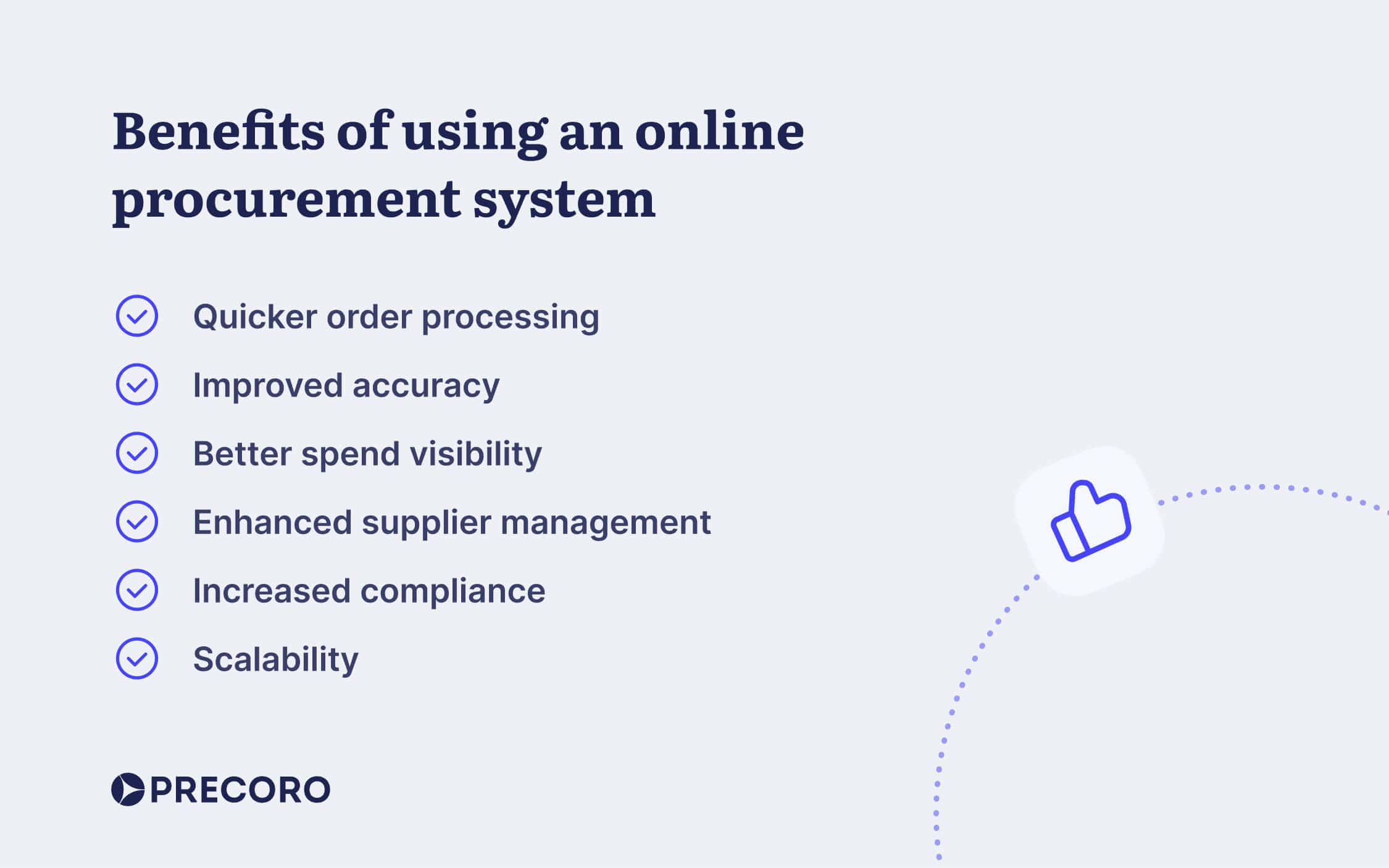
Choosing the right online procurement system
There are lots of e-procurement software vendors, all with different capabilities and core values. How can you choose the tool that fits your company’s workflows and needs? While we already listed features and modules needed to automate the whole procurement process, there are also other important aspects of e-procurement software platforms that should be taken into account.
Factors to consider besides features
When choosing the right online procurement system, it's important to look beyond just the features. Several other factors can significantly impact the platform’s effectiveness and suitability for your organization, such as:
1. Security
Security is paramount when dealing with sensitive procurement data, including supplier information, financial transactions, and internal budgets. Ensure the e-procurement software has robust security measures, such as:
- Protected infrastructure with reliable cloud hosting, daily backups, and regional backups.
- Multi-factor authentication and SSO capabilities to ensure that only authorized personnel can view or modify procurement data, thus protecting your organization from data breaches and fraud.
- Adherence to major compliance standards (for example, GDPR, SOC, CCPA) to fully uphold your privacy rights.
It’s also important to check the online procurement system’s uptime commitment to ensure it’s fully operational and available to customers at all times.
If your team requires remote access to procurement tools from multiple locations, choosing a solution compatible with secure USA-based RDP servers can further enhance both accessibility and data protection.
2. Customer support
Reliable and responsive customer support is crucial for the smooth implementation and ongoing use of the system. The top e-procurement software vendors have multiple channels of support, such as:
- Online chat support
- Email support
- Help Center with comprehensive descriptions and instructions to the e-procurement management software
- Video tutorials with personalized instructions, if needed
Usually, e-procurement software vendors assign a dedicated customer success manager to each company. They serve as a reliable point of contact who can promptly address any issues and offer personalized training sessions. This ensures that your team can fully utilize the system’s capabilities, minimizing downtime and maximizing productivity.
3. Integrations
To ensure smooth operations and collaborations across departments, it’s important to make sure that an online procurement system seamlessly integrates with your existing business tools, especially ERP and accounting software. Also, some e-procurement software platforms offer API, giving companies an opportunity to build any custom connection from Precoro to their preferred tools.
When online procurement software integrates with other systems, it allows for the automatic synchronization of procurement data, reducing manual data entry and errors. This provides a unified view of financial and procurement activities, streamlining processes and enhancing overall efficiency.
4. User-friendliness
Online procurement software should be straightforward and easy to use for all stakeholders, from requesters to approvers to financial managers. Look for e-procurement software vendors that offer a user-friendly interface, which reduces the learning curve and encourages adoption across the organization.
If you’re worried that a system with comprehensive procurement features will be difficult to use, rest assured that's not the case. Online procurement management systems typically prioritize ease of use, as users tend to avoid software with overly complex modules. Choosing a tool with a good user interface is essential because it ensures that employees will consistently create, approve, and track documents and budgets within the system.
5. Scalability
Stay a step ahead and make sure you not only focus on your company’s current requirements but also what it may need in the future. As a business grows, it can open new locations or departments, hire more employees, or increase its volume of purchases. An online procurement system should accommodate additional users and manage the increased number of procurement documents and transactions without requiring a complete system overhaul.
While it’s possible to switch tools later, it's much more efficient to choose scalable e-procurement software for small businesses from the start. Switching platforms requires significant time, extensive data cleansing and migration, and considerable financial investment. Additionally, transitioning to a new e-procurement system will most likely temporarily disrupt workflows since retraining for employees would be required.
6. Customizability
The ability to customize the electronic procurement system to fit your specific procurement workflows and requirements is essential. A customizable online procurement management system can adapt to unique business processes, reducing the need for manual workarounds and increasing overall efficiency.
For instance, you might need to tailor approval workflows to match your organization’s hierarchy or modify order forms to include specific fields relevant to your industry. Additionally, custom reports allow you to track the metrics that matter most to your business, such as supplier performance or spending by department. By using an e-procurement software platform that aligns perfectly with your operations, you can ensure a higher adoption rate among employees and gain more accurate and actionable insights from your procurement data.
7. Vendor reputation and reviews
Research the vendor’s reputation and read reviews from other customers. Check out G2, Capterra, or Clozdesk to get insights into other users’ experiences with the e-procurement software solution and gauge its reliability and performance in real-world scenarios.
This step helps you identify any potential issues or limitations before making a commitment. Furthermore, learning from the experiences of other users can provide practical tips and best practices for maximizing the benefits of e-procurement software.
8. Mobile accessibility
Mobile accessibility is vital because it ensures that urgent procurement activities aren’t stalled if a user is not at their desktop computer. A mobile-friendly platform also allows users to create and approve purchase requests, track orders, and manage invoices directly from their smartphones or tablets, ensuring continuity and efficiency regardless of their location.
Industries such as construction, where site managers are frequently on location, and retail, where sales representatives need to access inventory and place orders quickly, can benefit greatly from mobile procurement. For example, a field manager can instantly approve a purchase request via the online procurement system while at a job site, preventing delays in procurement processes. Additionally, companies with a dispersed workforce, such as logistics and transportation, where employees are often in transit, can see significant improvements in efficiency and responsiveness with available mobile access.
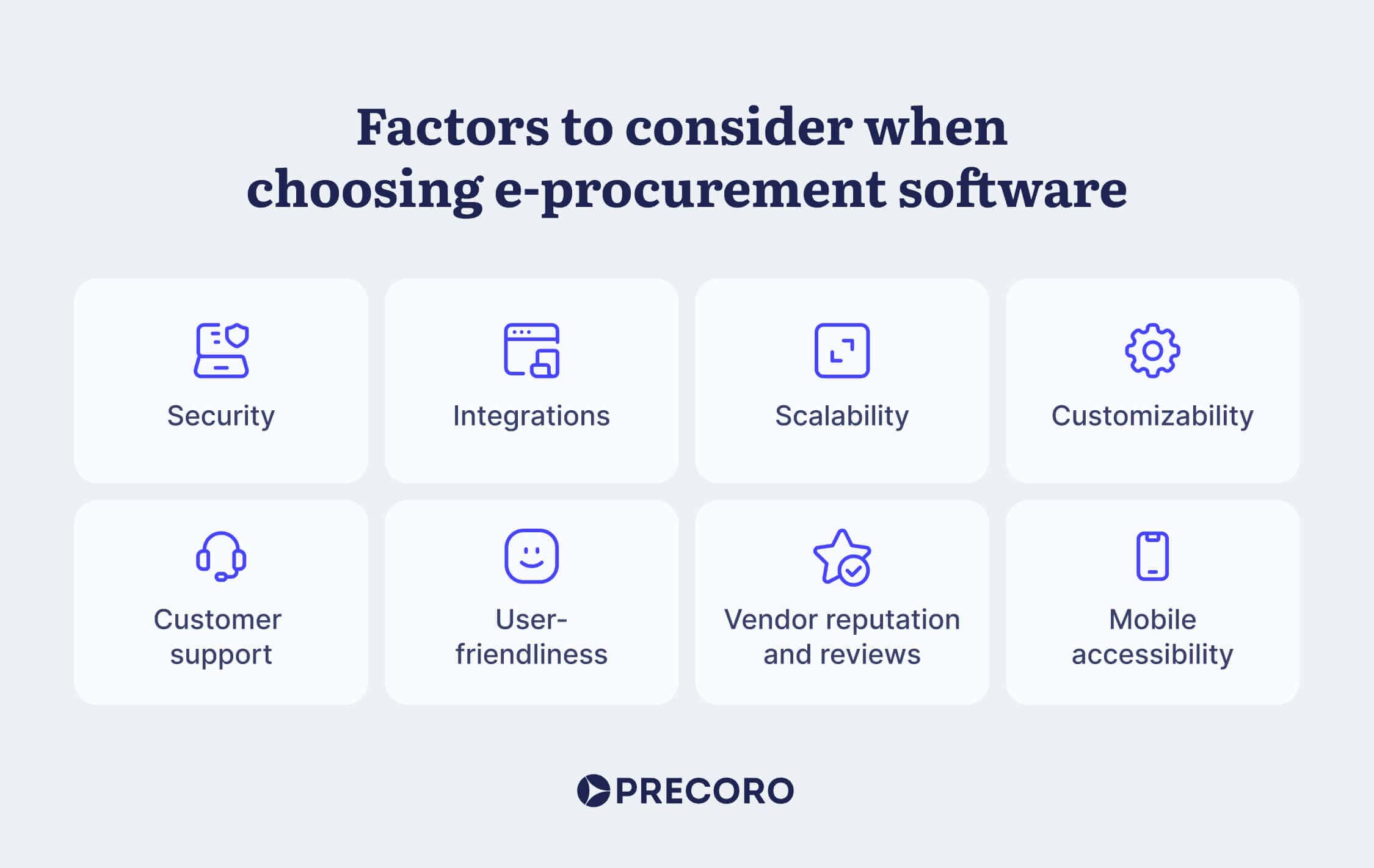
The steps to choosing an e-procurement software vendor
Choosing the right online procurement management system involves a thorough and systematic approach to ensure you select a solution that aligns with your organization’s needs and goals. Here are the key steps to guide you through the decision-making process:
1. Identify your requirements
Begin by clearly defining your procurement needs and objectives. A good place to start is to think about the pain points in the current manual procurement process. Gather stakeholder feedback on what pains them in spreadsheet-based operations and what they lack. Identify requirements for the online procurement management system from requesters, approvers, buyers, and upper management.
Additionally, identify factors beyond the system’s modules that affect the software usage experience. For example, consider security standards, integrations with your accounting or ERP software, and customizability.
2. Research potential vendors
Conduct thorough research to identify potential e-procurement software vendors. Use resources like G2, Capterra, Crozdesk, Gartner, and industry reports to compile a list of vendors with strong reviews and relevant features. Then you can compare your list of top e-procurement software vendors, considering factors like pricing, scalability, and specific features that meet your business needs.
3. Request demos and trials
Reach out to the shortlisted vendors to request product demos and trial versions. This allows you to see the e-procurement software platform in action and assess its user interface, ease of use, and overall functionality. Experiencing the online procurement software firsthand provides a clear picture of how it will fit into your existing workflows and whether it can meet your specific needs.
You can also involve various team members in the evaluation process to gather feedback from different perspectives, ensuring the online procurement management system is user-friendly for all potential users. Demos and trials also allow users to identify any potential limitations or challenges that might not be apparent from product descriptions or reviews.
4. Compare costs and ROI
Analyze the total cost of ownership for each e-procurement system. It’s helpful to create a cost-benefit analysis to compare the upfront and long-term costs of each solution against the expected benefits. Costs typically include implementation, subscription fees, and any add-ons to the system. Consider the potential return on investment by evaluating how the e-procurement management software can improve efficiency, reduce errors, and provide insights on cost-saving opportunities.
5. Gather feedback from stakeholders
Involve key stakeholders from various departments in the decision-making process to ensure the chosen solution meets their needs. Their input and feedback are crucial for selecting an electronic procurement system that works well for all users. To gather their opinions and address any concerns, you can conduct meetings or surveys.
Typically, this process includes someone presenting the available options to these stakeholders, highlighting the benefits and limitations of each online procurement management system. This collaborative approach helps ensure that the final choice aligns with the diverse requirements of your organization.
6. Make an informed decision
After completing the evaluations and gathering feedback, compile all the information and make an informed decision. Choose the best e-procurement software that would meet your organization’s needs, offer the required features, and provide a good balance of cost and value.
It’s a good tactic to create a decision matrix to compare e-procurement software vendors based on criteria such as features, cost, support, and stakeholder feedback, helping you to make a well-rounded choice. By following these steps, you can systematically evaluate and select the online procurement system that will best support your organization’s procurement processes and strategic goals.
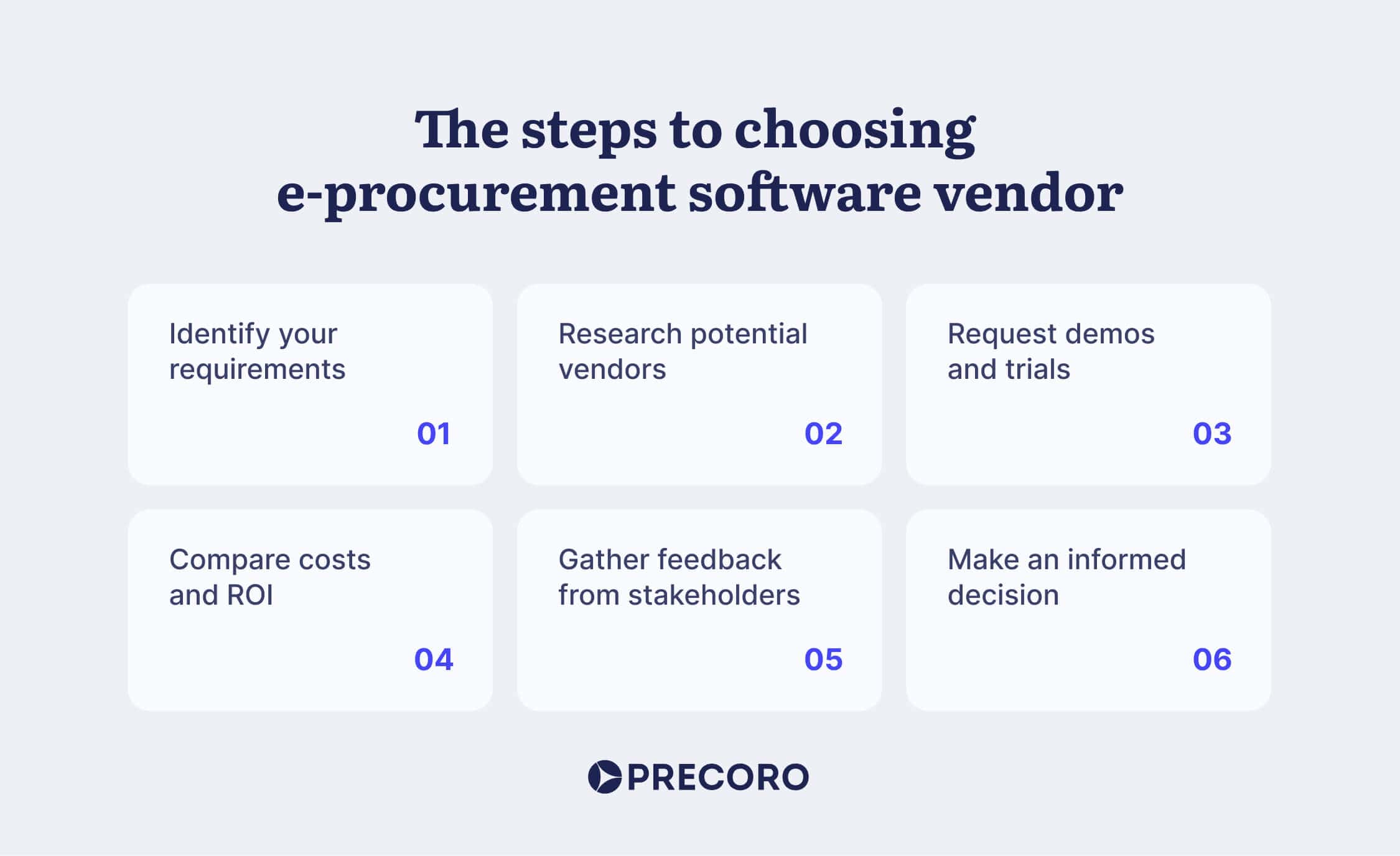
Frequently Asked Questions
E-procurement management software is a digital solution that helps companies automate and efficiently manage the procurement process. It streamlines tasks like requisition, approval, budgeting, invoice processing, supplier management, inventory control, and expense tracking.
ERP (Enterprise Resource Planning) systems integrate various business functions like finance, HR, and supply chain into one platform, providing a comprehensive view of operations. On the other hand, e-procurement software solutions focus specifically on managing and automating the procurement process, including purchasing and supplier management. They are often used as a complementary tool to an ERP system.
The major benefits of an e-procurement management software include:
The five steps of e-procurement are:
E-procurement management software automates a company’s internal purchasing processes, while a marketplace is an online platform where buyers and sellers engage in transactions.
E-procurement software for small businesses helps companies streamline purchasing, reduce costs, improve efficiency, and gain better visibility into spending, all of which contribute to better overall management and control.
Embrace software: e-procurement will become easy
Choosing the right online procurement management system is a critical decision for organizations. As businesses navigate the complexities of modern procurement, the benefits of adopting dependable e-procurement software become increasingly evident. These advantages include improved accuracy, full visibility into operations, quicker order processing, enhanced compliance, stronger supplier relationships, and scalability.
However, selecting the best e-procurement software for your company requires careful consideration of more than just features. Before deciding on a specific tool, it’s worth asking questions like:
- Does the electronic procurement system adhere to the major compliance standards?
- What kinds of customer support does it offer?
- Does this online procurement system integrate with our other business tools?
- Will it be easy to use for non-tech-savvy employees?
- What are its limitations according to customer reviews on classifiers?
- Will it be able to scale alongside your company, or is it just e-procurement software for small businesses?
- Can you configure the e-procurement system to fit the needs of your company?
- Can users access it from mobile devices?
By thoroughly evaluating these factors and ensuring that all essential modules for procurement operations are available in the online procurement software, e-procurement specialists can make budgeting, requesting, approving, buying, and expense control a breeze for the entire company.


